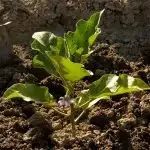The best companion plants for Aubergine are mostly from the Vegetable family, and this makes your Garden very rich with Vegetables that bring better yield and growth to each other.
Aubergine, sometimes known as eggplant, is a plant in the nightshade family Solanaceae.
In temperate regions, eggplant is a fragile, tropical perennial plant that is sometimes grown as a sensitive or half-hardy annual.
By botanical definition, it is a berry that is most typically purple. The blooms range in color from white to purple, and the stem is sometimes spiky.
Different varieties of the plant yield fruit that vary in size, shape, and color; however, the majority are purple.
Less common white eggplant kinds include Easter white eggplants, garden eggs, Casper, and white eggplant.
The flesh of the eggplant is smooth. Like the rest of the fruit, its many seeds are tiny, soft, and edible and do not need to be removed. Its thin skin is also edible, so there is no need to peel it.
When preparing an eggplant for cooking, the green area at the top, known as the calyx, must be removed.
This spongy and absorbent fruit is utilized in a variety of cuisines and is often cooked as a vegetable. Steamed, stir-fried, pan-fried, deep-fried, barbecued, roasted, stewed, curried, or pickled eggplant. Many eggplant meals have sauces made from mashed cooked fruit. It is stuffable, and it is commonly cooked with oil or fat is common, though not always.
Eggplant enjoys warmer conditions and will wilt or fail to set and yield ripe fruit if cultivated in cold regions or low-humidity environments.
Many of the pests and diseases that affect other nightshade plants (like tomato, capsicum, and potatoes), such as Aphids, whiteflies, Flea Beetles, Colorado Potato Beetle, Hornworms, Stink Bugs, and Spider Mites, also affect eggplants. As a result, it should not be planted in regions previously inhabited by its near relatives.
Companion Planting different plants besides eggplants in your Garden may provide several advantages to the plant. These advantages include repelling insects that attack the plant, improving soil nutrients for your eggplants, stimulating quicker development, attracting pollinators, and improving the flavor of your eggplant, among others.
So in this article, we will be going through Thirty-Five (32) Good companions of Aubergine and Five (5) Bad Companions of Aubergine, also the advantages of planting and not planting them.
Table Of Contents
| 1. Good Companion Plants For Aubergine |
| 2. Bad Companion Plants For Aubergine |
| 3. Things to plant in a container with Aubergine |
| 4. Things to plant after eggplant |
| FAQs |
Good Eggplant Companion Plants
1. Amaranth

Amaranthus is a worldwide genus of annual or short-lived perennial plants commonly referred to as amaranths. Some amaranth species are grown for their leaves, pseudocereals, and aesthetic plants. All sections of the plant are edible; however, some may have sharp spines that must be removed before eating.
Amaranth is a great companion plant since it takes up the same amount of area as eggplant and can be split evenly in the same plant bed. They also grow well in situations similar to harvest.
Amaranth also helps loosen the soil for drainage and repels several insects that may harm the eggplant, such as aphids, whiteflies, and flea beetles.
2. Basil
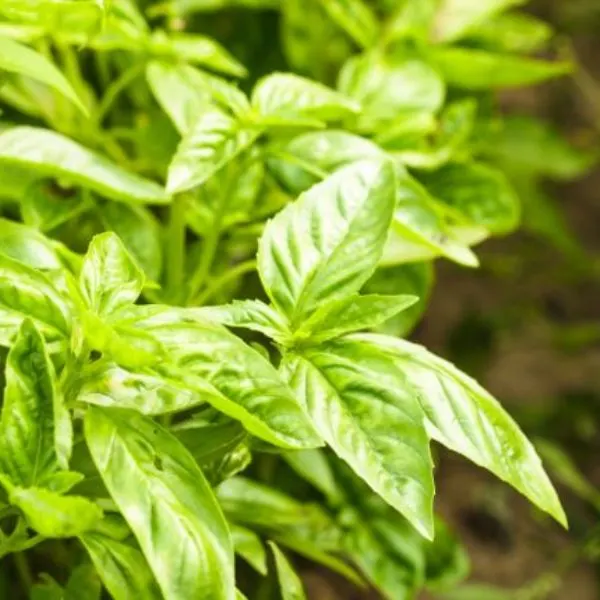
Basil belongs to the Lamiaceae family of culinary herbs (mints). It is sometimes referred to as sweet basil or Great Basil. It is a delicate plant that is used in many different cuisines around the world. Basil tastes different depending on the variety. But most of all, the Basil cultivars have a slightly peppery and minty taste. Basil is an herb that is normally annual but may potentially be perennial.
Basil is another herb that might act as a Good companion plant for eggplants. This is because of its capacity to divert insect pests away from your plants. Their distinct odor is highly effective against aphids and garden moths that attack Eggplants.
3. Beans
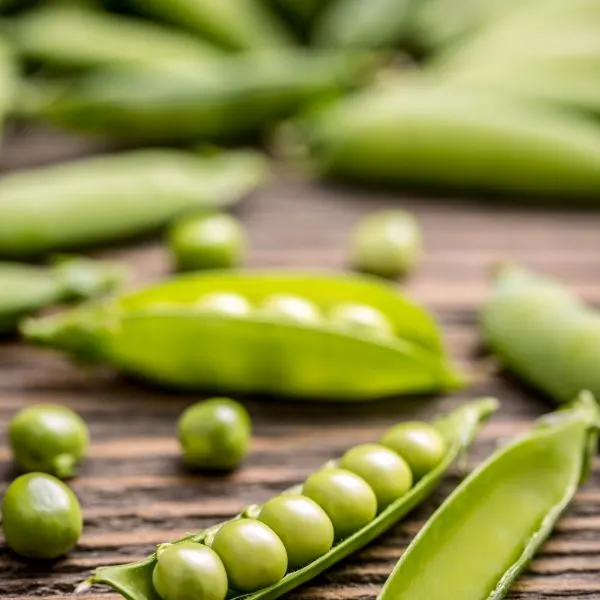
Beans are the seeds of one of the many genera of the Fabaceae flowering plant family, which are grown as vegetables for human and animal consumption.
Beans are high in iron, folate, complex carbohydrates, and protein.
Beans are a legume that will significantly improve performance by fixing atmospheric nitrogen and making it available for use by eggplants. This is richer, better, and less expensive than applying fertilizers.
Planting eggplants after harvesting beans is another way to get them to grow well. After harvesting, legumes leave a rich residue in the soil. It’s a good idea to plant your eggplants after you’ve harvested your beans. Green beans are the greatest type of bean to grow with eggplant.
Also, planting eggplants among beans protects them from the Colorado potato beetle’s attacks. Plus, they’re extremely profitable by planting them in your yard each growing season because green beans can be used in the same recipes as eggplant, such as eggplant string-bean stir fry.
4. Borage
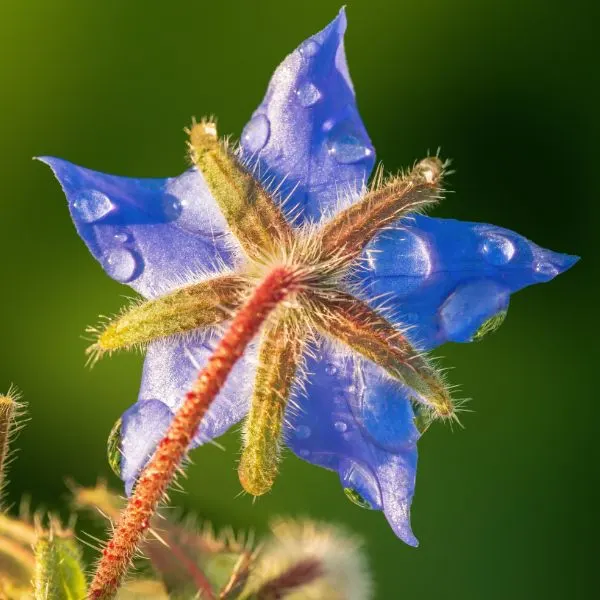
Borage, also known as starflower, is a flowering plant in the Boraginaceae family. Borage leaves can be eaten fresh or dried as a vegetable or herb.
Borage repels beetle larvae and worms. It also attracts bees and birds and can be used if worms or caterpillars are eating your eggplant, and this can aid in the control of the eggplant pest.
Borage is an excellent eggplant companion plant because it has star-shaped blue blossoms that attract pollinators such as bees. The bees will then pollinate your eggplant flowers as well.
5. Broccoli
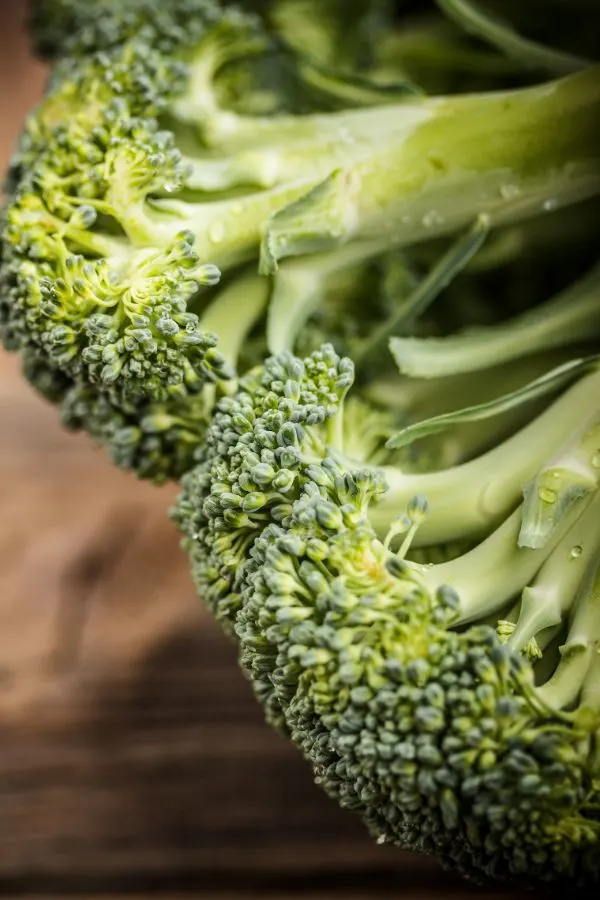
Broccoli belongs to the Brassicaceae family and the genus Brassica. The plant’s huge blooming head, stem, and little auxiliary leaves are consumed as vegetables. It may be eaten raw or cooked in a variety of ways, including stir-frying, steaming, or microwaving.
Because eggplants are heavy feeders, they need a lot of nutrients to develop healthily; thus, planting broccoli alongside eggplants offers extra nutrients to the soil for the eggplant to receive and thrive. As a result, Broccoli is an excellent companion plant for Eggplants.
In turn, Broccoli will be protected from heat during hot times since eggplant will shade it.
6. Bush Beans
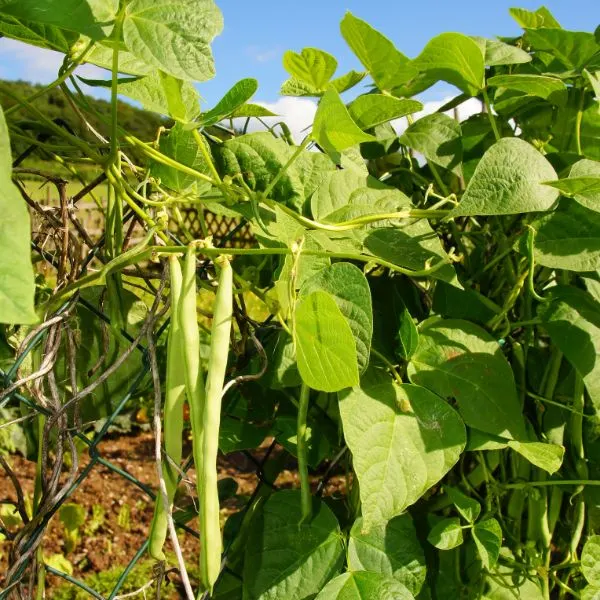
Bush bean, also known as the common bean or French bean, is an herbaceous annual plant used for its delicious dry seeds or unripe fruit worldwide (both commonly called beans).
It is classified botanically as a part of the legume family Fabaceae, along with other Phaseolus species. Dried beans are usually always cooked by boiling, often after soaking for several hours in water. While the soaking isn’t technically essential, it does save cooking time and produces more uniformly textured beans.
Bush beans, like other legumes, provide nitrogen to the soil. And providing nutrients to the garden soil can help your eggplants and may even remove the need for you to apply nitrogen fertilizer to the soil if you have enough.
However, you should constantly evaluate the soil’s nutritional profile since too much nitrogen is also undesirable. This might cause your eggplant to produce less fleshy parts and more foliage.
Another advantage that beans provide to the eggplant garden is that they resist a major pest of eggplant, the Colorado potato beetle. This promotes growth and development for increased crop output.
7. Cabbage
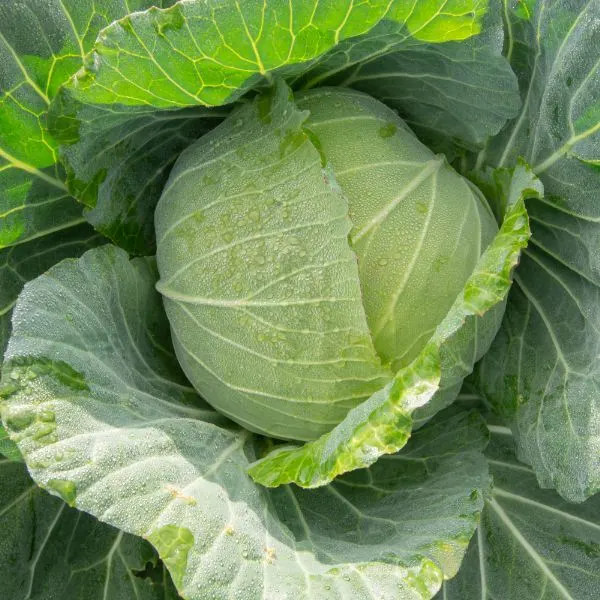
Cabbage is a biennial plant that contains numerous varieties of Brassica oleracea. It is a leafy green, scarlet (purple), or white (pale green) plant used as an annual vegetable crop for its densely-leaved heads. The bulk of its applications is for Culinary purposes.
Cabbage, like Nasturtium, may be utilized as a trap crop, luring insects away from your eggplant and directing them to the lush green. This is very effective against insects such as the flea beetle.
They prefer cabbage over eggplant; thus, it may be employed as a decoy plant to deter pest attacks in general. Chinese cabbage, in particular, attracts flea beetles and keeps them away from eggplants. This makes cabbage a good companion plant for eggplant.
8. Catnip

Catnip is a minty herb of the Labiatae family. Catmint, sometimes known as catswort, is a plant of the genus Nepeta in the Lamiaceae family. Catnip is used in various herbal drinks because of its calming and relaxing effects.
Flea bugs are one of the eggplant’s most disastrous pests. So, when you grow Catnip and eggplant together, you have a combination that is pest-free because Catnip will deter Flea bugs away from your Eggplants.
Catnip, on the other hand, should be planted with eggplant and no other legumes nearby since they will fight for nutrients in the soil, causing both to grow stunted and not attain their maximum harvest yield. Catnips are also very appealing to cats, so if you have cats or a neighbor who does, you should take some steps before they overrun your Garden.
9. Cilantro

Cilantro is an annual member of the Apiaceae family. Coriander is another name for it. Except for the fresh leaves and dried seeds, all plant components are edible.
Fresh leaves are often used as a garnish for soups, fish, and meat meals, as well as a component in chutneys, salads, salsa, and guacamole.
They may be used to deter pests and keep your Garden feeling wonderful. They also attract natural predators to the Garden to consume the beetles and can help protect your eggplant from pests.
10. Dill
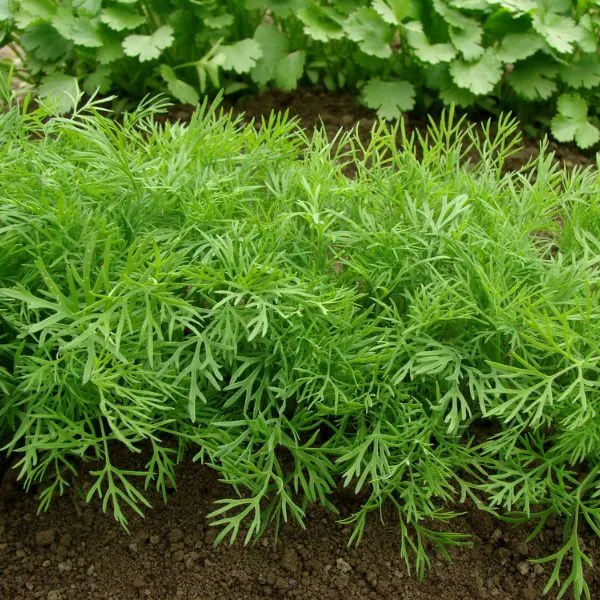
Dill is an annual herb that belongs to the Apiaceae (celery) family and is used to flavor dishes. Chefs produce culinary spice from dill seeds. Dill is best used fresh since it loses taste quickly when dried. However, freeze-dried dill leaves keep their flavor for many months.
Dill is one of several herbs that are popular as companion plants due to their pest-repellent properties. It is also one of the herbs that enhances the flavor of other vegetables grown nearby.
Planting dill with eggplant attracts beneficial insects such as bees for pollination. They also keep aphids away from your Garden.
11. Kohlrabi
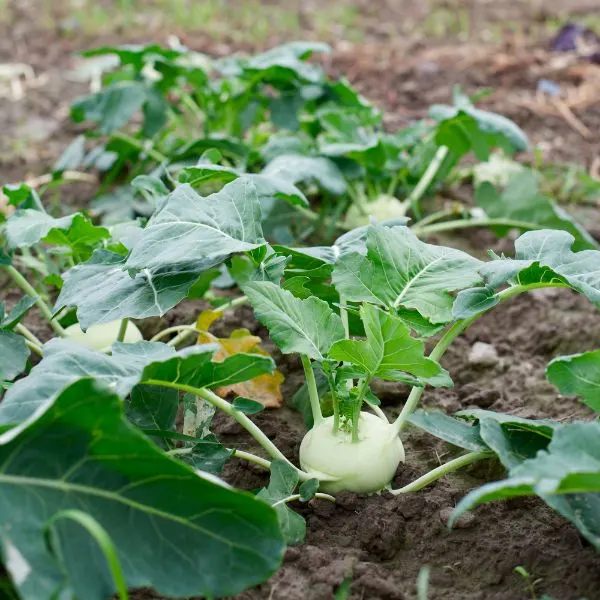
Kohlrabi is a biennial vegetable that is also known as German turnip or turnip cabbage. It belongs to the same species as cabbage, Broccoli, and cauliflower. It may be consumed raw or cooked. Both the stem and the leaves are used to make edible recipes.
Kohlrabi is a bitter, leafy green that may be used to repel insects. If you utilize Kohlrabi as a barrier crop for your eggplant, aphids, cabbage moths, and flea beetles will avoid it.
Furthermore, on hot days in the summer, it might help protect your eggplant from the burning heat.
Although eggplant prefers full sun, it does not like sunburn in the afternoon. Aside from these benefits, it also serves as a ground cover for eggplant when grown together in gardens.
12. Lemon balm

Lemon balm is an herbaceous perennial plant of the mint family. The leaves are used as an herb, in drinks, and to flavor foods. The plant is used to attract bees in order to produce honey. It is planted for both decorative purposes and for its oil (to use in perfumery).
Another herb that works nicely with eggplants is lemon balm. It contains a natural citrus aroma that keeps critters out of unwanted pests like snails, slugs, spiders, pillbugs, and others away from your plant bed.
Both of these plants will benefit greatly from the shade given by your eggplant. However, they are both invasive in the soil, so I would recommend putting them in containers near eggplants so that they will not end up fighting for the same soil.
Their aroma will also help attract beneficial pollinators while repelling pests like aphids and whiteflies from your eggplants.
13. Lentils
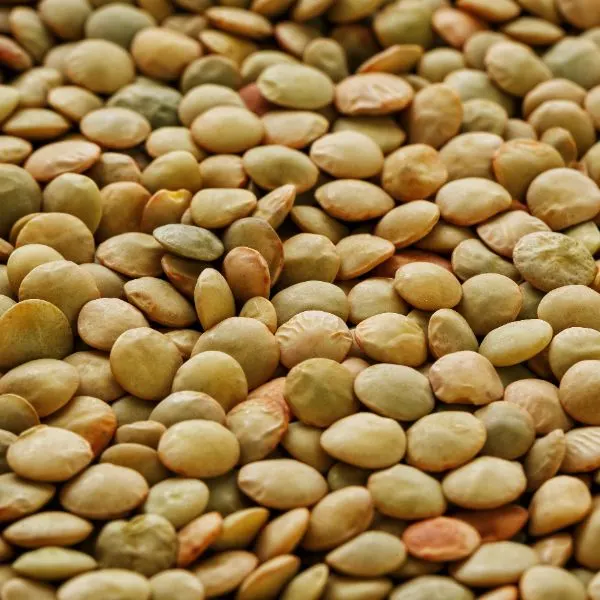
Lens culinaris or Lens esculenta is a kind of edible legume. It’s an annual plant with lens-shaped seeds. Lentils may be consumed soaked, germinated, fried, baked, or boiled, which is the most frequent form of preparation.
Lentils, which may be planted in the same plot as eggplant, increase nitrogen synthesis in the growing substrate, allowing eggplants to flourish, making it one of the greatest eggplant companion plants.
This may reduce the requirement for Nitrogen supplementation.
After the growth season, cut the pea plants off so that your eggplants may take over the abandoned area and consume the roots as compost.
14. Lettuce

Lettuce is an annual plant of the Asteraceae family. Lettuce is most often used in salads, but it may also be found in soups, sandwiches, and wraps; it can even be grilled. Celtuce (asparagus lettuce) is farmed for its stems, which may be consumed raw or cooked.
Lettuce and salad grow swiftly, do not send down deep roots, and do not need as many nutrients as your eggplant, which is a Heavy Feeder. So, this makes Lettuce one of the Good companions of Aubergine.
Also, you may collect lettuce leaves, and they will continue to develop throughout the summer, but eggplant harvesting starts much later, so you can harvest greens in early summer and eggplants in late summer. This is a fantastic combination of these Plants.
15. Marigold
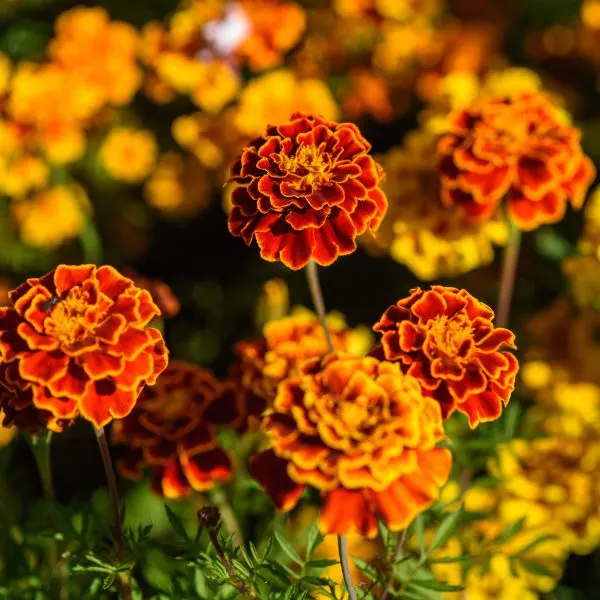
The Marigold is one of the members of the Asteraceae family, often known as the Tagetes family, and is mainly constituted of annual or perennial herbaceous plants. It has been employed as a flavoring element in cuisine and as a source of marigold oil, an essential oil.
Because of its inherent pest-repelling characteristics, Marigold is one of the finest blooming plants to pair with eggplant. It also attracts a lot of bees and birds, which will help pollinate your eggplant and themselves. Marigolds may also be used to give color to your landscape.
If you have aphids, ants, flies, or flea beetles eating your eggplant, try spraying it with MarigoldMarigold. The bloom also keeps nematodes at bay. However, beans should not be grown in the same soil as marigolds or eggplants since they are poisonous to their development.
16. Mint

The Lamiaceae, sometimes known as the mint, deadnettle, or sage family, is a flowering plant family. It, like basil, is utilized as a culinary and medicinal plant.
Mint’s smell can help attract beneficial pollinators to your Eggplants while repelling pests like aphids, whiteflies, and the rest.
Mints benefit from the shade given by your eggplant as well. However, they are both invasive in the soil; therefore, it is best to keep them in pots next to eggplants but not fight for the same soil.
Peppermints, spearmints, and winter mints are the finest mints to grow using Eggplants.
17. Nasturtium
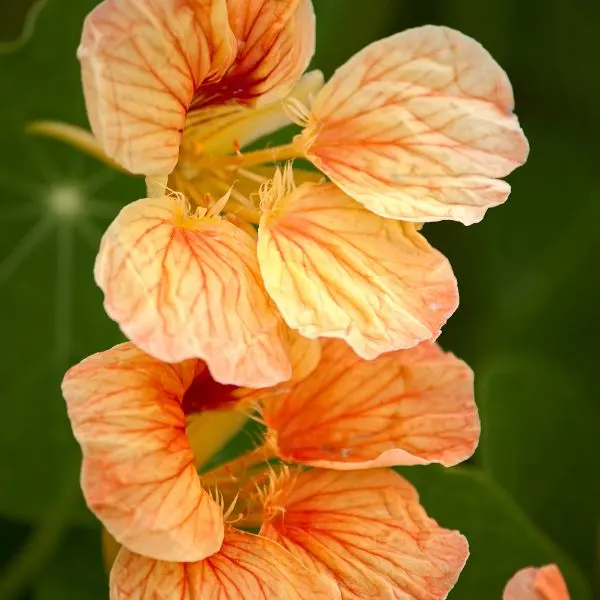
Nasturtium is a genus of a few plant species in the Brassicaceae (cabbage family) that is sometimes known as watercress or yellowcress. Nasturtium leaves, which are antibacterial, may be applied to wounds to help fight infection.
Nasturtiums have lovely blossoming blooms and may be cultivated near eggplants to act as a decoy (trap crop) to attract insect pests such as aphids. They will be lured to the Nasturtium rather than the eggplant itself. It’s inexpensive, simple to cultivate, and may be sacrificed to pests to keep your eggplant growing.
Nasturtium may be used as a ground cover to keep weeds away. Because eggplant is a member of the nightshade family, it thrives when planted alongside other nightshades. In addition, Nasturtium is a lovely flower that may enhance the attractiveness of your farm besides your eggplant.
18. Nightshades

The Solanaceae, or nightshades, are a flowering plant family that contains a variety of agricultural crops, medicinal plants, spices, weeds, and ornamentals, as well as annual and perennial herbs, like vines, lianas, epiphytes, shrubs, and trees.
Many are utilized as food, including tomatoes, potatoes, eggplant, bell, and chili peppers.
Because eggplant is a nightshade, it is an excellent option for planting with other members of the same family. They all have comparable soil, sunshine, pH, irrigation, and fertilizer requirements; therefore, they complement one another.
At the same time, if you receive a pest infestation, all of your plants will be afflicted. There may also be rivalry among the plants since their nutritional requirements are comparable.
However, if you offer enough by using high-quality organic soil and supplementing as required (using a soil meter), you may have a plot of vegetables that can all be treated in the same manner.
19. Okra

Okra, also known as ladies’ fingers in many English-speaking countries, is a blooming plant of the mallow family. It bears green seed pods that are delicious. Pods are consumed raw, boiled, pickled, or in salads.
Okra has comparable watering needs as eggplant and may help enhance nitrogen content in the soil.
You can water, feed, and plant all simultaneously in the same location. Because their demands are so similar, they go hand in hand.
They both have comparable soil requirements, sunshine requirements, watering requirements, and fertilizer requirements.
20. Oregano
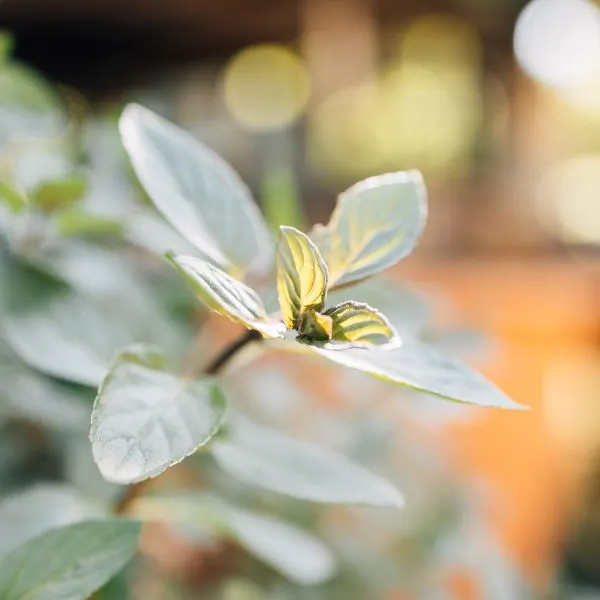
Oregano is a woody flowering perennial plant of the mint (Lamiaceae) family. It’s a potent plant with a peppery sting and a minty fragrance. The taste of dried oregano leaves may be stronger than the flavor of fresh oregano leaves.
Oregano is the companion plant you need to keep spider mites, aphids, and cabbage moths away from your eggplant. They also attract pollinators like ladybugs and honey bees, both of which are healthy and essential to the Garden.
Pests such as aphids, cabbage moths, and spiders may completely kill your eggplant. Planting Oregano, which may repel these pests, is one of your best solutions. Oregano emits a fragrance that repels these pests. Oregano also improves the flavor of eggplants when grown alongside it.
21. Peanuts

The peanut is a legume crop that belongs to the botanical family Fabaceae (or Leguminosae), usually known as the legume, bean, or pea family. It is mostly planted for its tasty seeds.
Peanuts are beneficial as companion plants. They have a wonderful interaction with eggplant since they have distinct roots. They have the ability to capture air nitrogen and make it accessible to eggplants. If they are, this is really useful since eggplant is a heavy eater and requires every nutrient it can receive.
But bear in mind that growing peanuts isn’t for everyone, and it might vary depending on where you live. This is due to the fact that peanuts need 600 to 1500 mm of rainfall and a frost-free period of around 150 days.
22. Peas
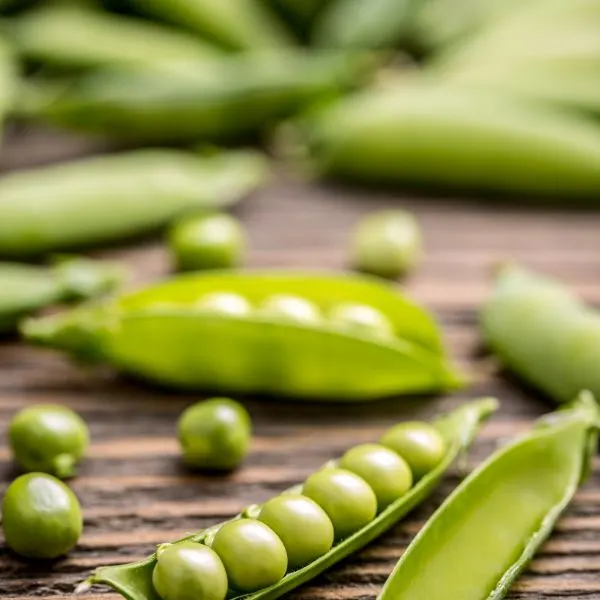
The pea is most often defined as the little spherical seed or seed pod of the flowering plant Pisum sativum. Each pod includes a number of green or yellow peas. Peas are annual plants with a one-year life cycle. Peas are often cooked or steamed, which breaks down the cell walls and improves the flavor and bioavailability of the nutrients.
Peas contribute nitrogen to the soil by collecting it from the air and depositing it in the garden soil for the eggplants to absorb. In exchange, when grown close to one another, Eggplants boost the flavor of Peas.
23. Peppers
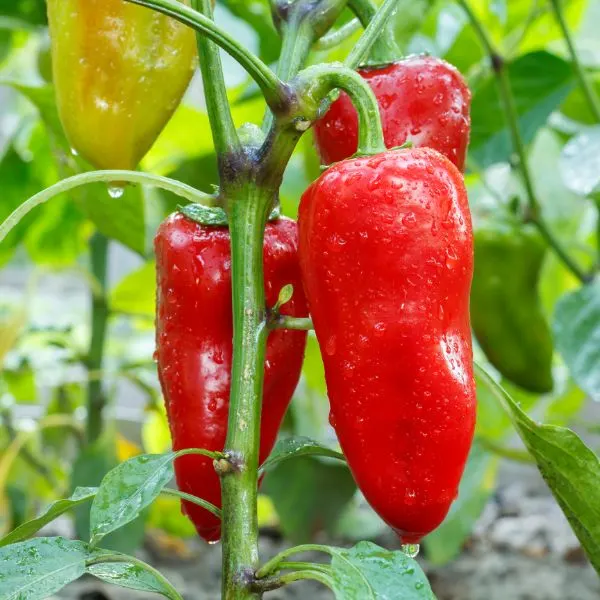
The fruit of plants of the Grossum Group is known as pepper; it is also known as paprika, sweet pepper, pepper, or capsicum. Although bell peppers are botanically a fruit, they are categorized as a vegetable. Green, yellow, orange and red bell peppers are popular varieties of pepper.
Peppers may be grown with eggplants of any kind. They may also assist in keeping pests out of your plant bed. Both sweet and spicy cultivars have similar growth requirements and will make excellent companion plants for your eggplants.
Pepper also supports the root system by introducing a substance that prevents rot and fungus under the soil.
However, you should regularly evaluate your soil metrics since competition will result in lower crop output and plant development because they both demand the same nutrients to flourish.
Stake them securely and keep them at a safe distance away from the fragile eggplants.
You may also combine the flavors of these crops for culinary reasons since they form a delicious meal combined.
24. Pigweed

Amaranthus retroflexus is a flowering plant of the Amaranthaceae family that goes by numerous names, including red-root amaranth, redroot pigweed, red-rooted pigweed, common amaranth, pigweed amaranth, and common tumbleweed.
This plant is consumed as a vegetable in several parts of the globe. The pigweed family contains several species, but the most popular, at least in terms of companion planting, is redroot pigweed. It may also be eaten as a vegetable.
One of the benefits of pigweed as a companion plant is its capacity to loosen the soil and make it easier for newly sprouted eggplant roots to settle in. They also collect nutrients from the soil’s deep entrenches and transport them to younger Eggplants with less deeply rooted plants.
In addition, redroot pigweed makes eggplants more resistant to insect pest attacks. Also, rabbits like pigweed, so avoid it if you don’t want rabbits having a good time in your yard.
If you’re prepared to put in the necessary work to trim out the pigweed, it makes a fantastic eggplant companion plant. Also, bunnies like pigweed, so keep an eye out for them.
25. Poles Bean
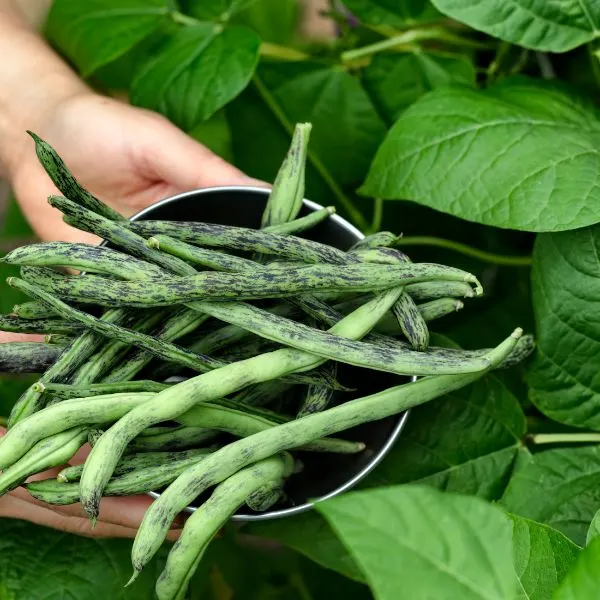
The common bean, sometimes known as the French bean, is a herbaceous annual plant farmed for its delicious dry seeds or unripe fruit (both commonly called beans). Pole beans come in a variety of hues and may grow to be several feet long. The pods are edible, and these beans are deliciously steamed, stir-fried, or added to stews.
Pole beans, being a legume plant, provide nitrogen to the soil, but eggplants need a considerable quantity of nitrogen in the soil to survive. This is precisely what happens when you grow pole beans with eggplants. Pole Beans are an excellent companion for eggplant in the Garden.
In addition, Colorado bugs attack the eggplant leaf. If you have potato bugs devouring your eggplants, pole beans may help keep them at bay and repel them naturally.
However, avoid putting pole beans very near eggplants since their height will tower over them and perhaps obstruct sunlight from reaching your low-riding eggplant.
26. Radish
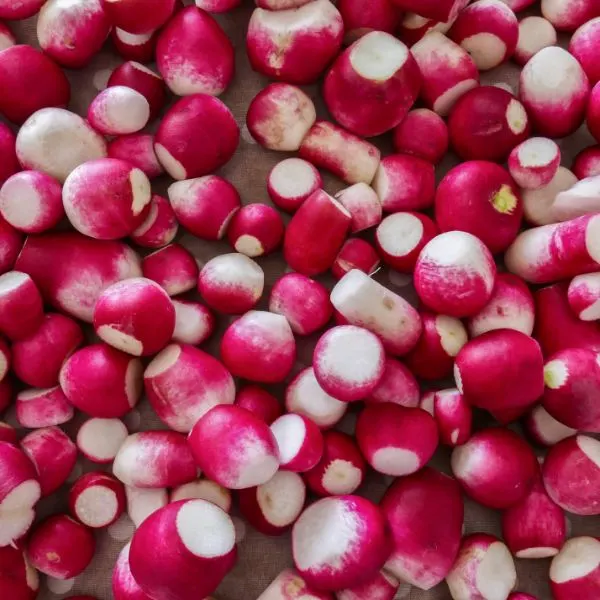
Radish is a tasty vegetable that is popular all around the globe. They are one of the fastest-growing plants, which takes less than 30 days from germination to maturity. The radish has many functions. During the winter, gardeners use it as a catch crop or cover crop.
Radishes are also excellent companion plants. If you’re growing in a small location and don’t have a place for a lot of needed plants, radish takes up very little space and may be planted alongside your eggplants.
This companion plant, like nasturtiums, attracts flea beetles, which means it may also function as a trap crop, so put it at a safe distance from your eggplant.
27. Rosemary
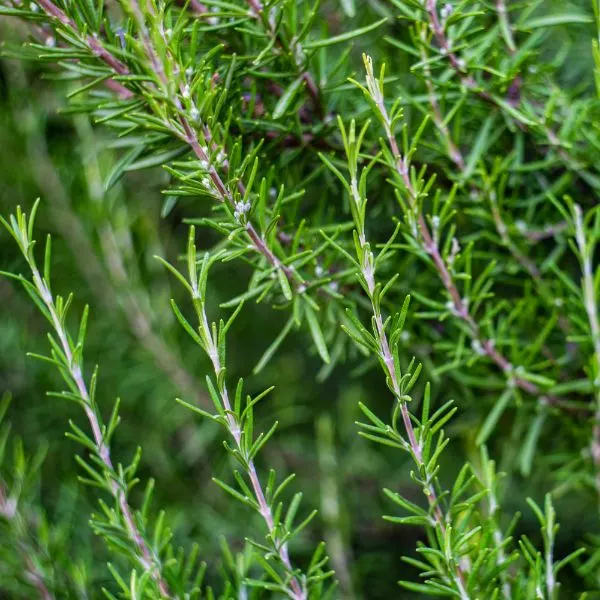
Rosemary is a perennial plant with evergreen foliage and blue flowers. It is a fragrant plant with a sweet and resinous flavor. It belongs to the Lamiaceae family of sages and contains many other medicinal and culinary herbs.
Rosemary is a fantastic herb that works well with eggplants. This herb has a strong aroma and is highly effective in keeping Colorado potato beetles, aphids, cabbage moths, and spider mites away from your eggplants since eggplant favors herbs with a strong perfume. This allows your eggplant to grow healthy and free of potato pests and saves you money on pesticides.
It will also attract helpful insects like bees, ladybugs, and other pollinators. They also contribute to the flavor of your eggplant. As a result, it makes an excellent companion plant for eggplant.
28. Sage
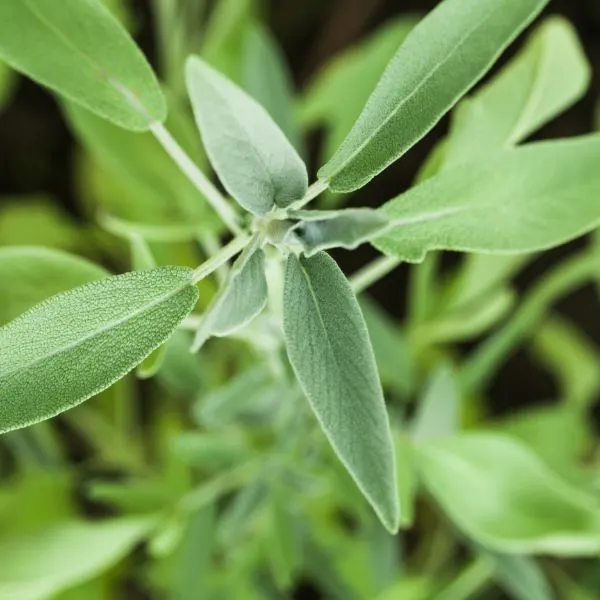
Salvia officinalis, often known as sage, is the biggest genus of plants in the Lamiaceae sage family.
Salvia species include annual, biennial, and perennial herbaceous perennials. It is mostly used in cooking.
Sage and eggplant go great together. It provides a fragrance that helps keep insect pests away from eggplant. Planting sage and eggplant will provide you with a diverse herb as well as highly productive growth without the interruption of insect pests.
29. Spinach
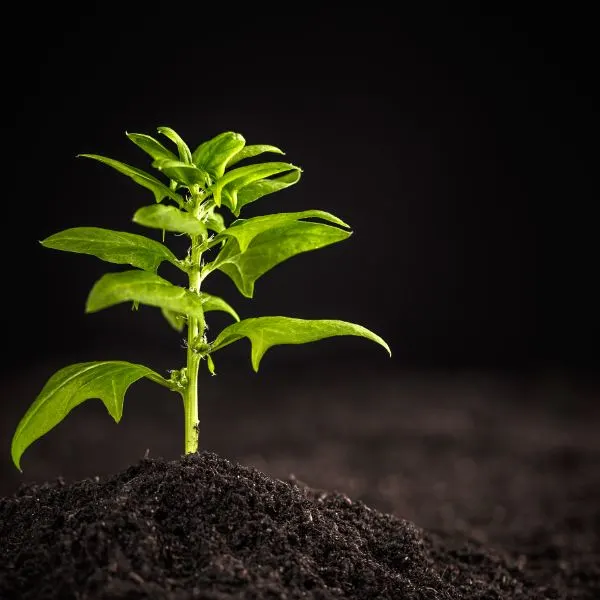
Spinach is a leafy green with long leaves that may be utilized. It is an annual plant (rarely biennial). Its leaves are a popular culinary vegetable eaten fresh or after storage by canning, freezing, or dehydration processes. It may be eaten cooked or raw, and the flavors vary greatly.
Eggplant often grows higher than spinach, providing shade for the spinach. While the spinach aids in the development of the eggplant by conserving moisture in the soil, the eggplant protects the spinach from the harsh sun by giving just the appropriate amount of shade.
However, you should produce smaller types of spinach. The shade it provides is beneficial to the spinach, and the spinach may assist shield the soil from evaporating water, allowing you to water less often.
Both plants benefit from their symbiotic connection, as spinach aids in the development of eggplant, and eggplant aids in soil equalization for spinach. Because spinach prefers cooler weather, it will continue to grow after the eggplants have been harvested. It also helps keep weeds out of the plot.
30. Squash

Cucurbita is a genus of herbaceous fruits in the Cucurbitaceae family, also known as squash, pumpkin, or gourd. These gourds are used as utensils or vessels, and their young fruits are eaten.
Squash may be planted in the same plot as eggplant since it requires full sun to develop huge fruit. They both need 6 hours or more of sunshine each day; thus, both plants can be sunlight-hardy and planted together.
However, since squash, like eggplants, is a strong eater, you must keep an eye out for organic matter and soil nutrients to minimize competition.
31. Sunflowers
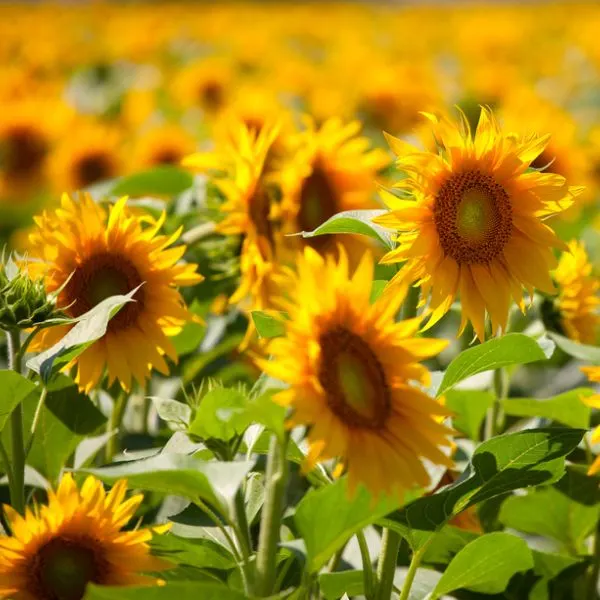
The sunflower family, Asteraceae, includes about 70 species of annual and perennial flowering plants in the genus Helianthus.
Humans consume sunflower seeds.
Sunflowers are another good option. Sunflowers are versatile, easy to grow, and attractive. They can help attract pollinators to your eggplant but lack the pest-repellent power of marigolds.
They will attract birds to your Garden, which will eat any beetles that are attracted to your eggplants.
Sunflowers are also a good companion for eggplant for these reasons.
32. Tarragon
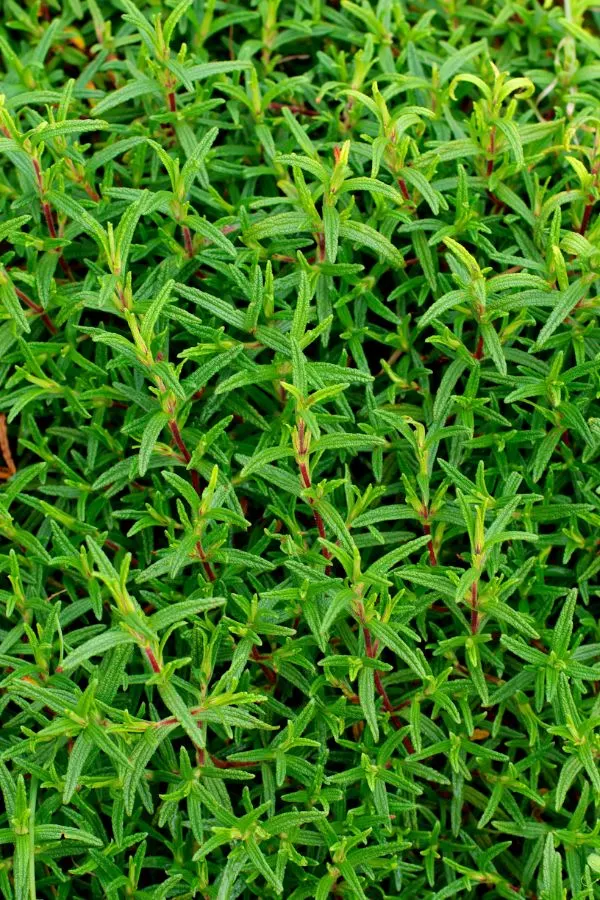
Tarragon, also known as estragon, is a perennial herb in the Asteraceae family.
French Tarragon is the kind used for cooking in the kitchen, especially ideal for chicken, fish, and egg dishes. Also, Tarragon has been utilized to flavor a popular carbonated soft drink. It has also been used for both medicinal and culinary properties.
Tarragon is another strong-smelling herb that repels a variety of insects, including aphids and spider mites, which feed on eggplants.
Furthermore, this herb enhances the taste of recipes, including eggplant. This makes it an excellent partner for eggplant.
33. Thyme

Thyme is the herb (dried aerial portions) of several members of the mint family Lamiaceae’s fragrant perennial evergreen plant genus Thymus. Many of the essential oils present in Thyme were also used as incense and put on coffins during funerals.
This herb has a strong perfume that attracts the correct insects, such as ladybugs and honey bees, who are fantastic pollinators, while repelling pests such as moths, worms/cabbage worms, and so on.
Because of their powerful scents, herbs like Thyme are good companion plants for eggplants. Because Thyme has such a strong odor, many pests will avoid visiting your eggplant.
Many people use Thyme to border nightshade plants like eggplants, which are prone to worm infestation. You may either plant it with Thyme or build a thyme border around your eggplants.
34. Tomatoes
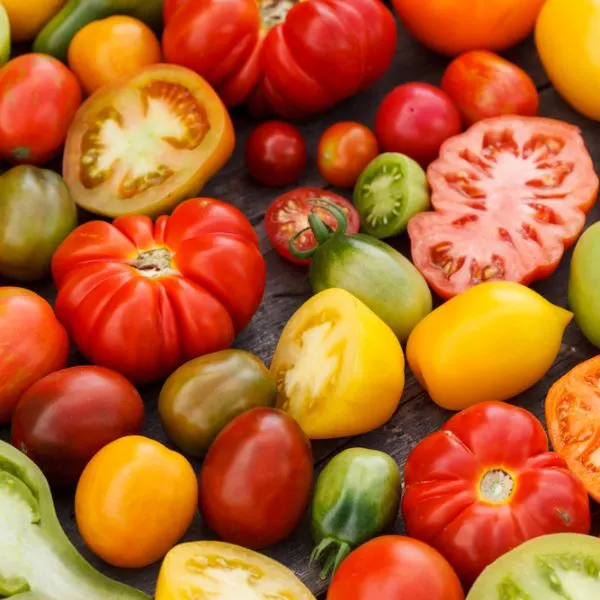
The tomato is an edible berry produced by the Solanum Lycopersicum plant, often known as the tomato plant.
Tomatoes are considered vegetables in the culinary world, yet their fruit is classified as a berry in the botanical world. It can be eaten fresh in salads or in slices, stewed, added to a wide variety of recipes, or made into ketchup or tomato soup.
Tomatoes are often utilized as eggplant partners since they like similar growth conditions.
Tomatoes and eggplants are members of the same plant family known as nightshade vegetables. If you grow it alongside other nightshade plants, you will notice that their needs are comparable and that they will require the same nutrients from the soil.
To keep your soil from becoming depleted over time, either engage in crop rotation or feed your plants on a regular basis. Also, Watch out for tall or large leaves that block the eggplant from getting its precious sunlight.
Tomatoes and eggplants complement each other well, and many dishes require the same ingredients, so you can harvest and grow them together.
Just make sure your tomato plants do not shade the eggplants (because they, too, require their daily dose of sunlight). Overall, tomatoes are excellent eggplant companion plants.
What not to plant next to eggplant
1. Black Walnut
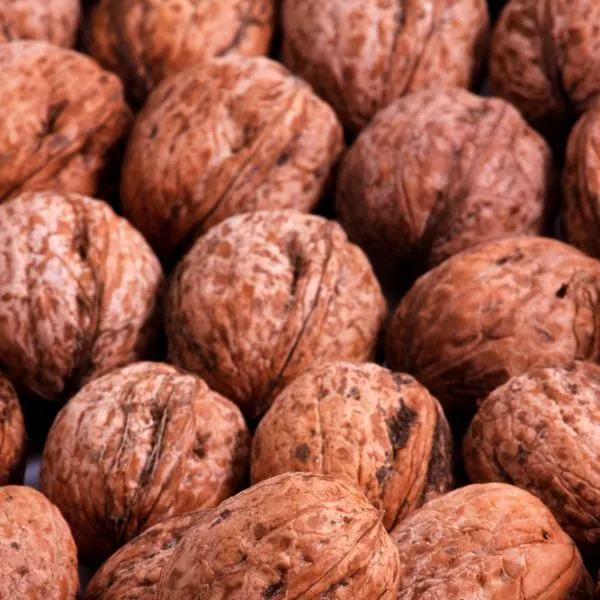
Black walnuts are allelopathic, which means they emit poisons that harm the development of plants near them and, in some cases, kill them, making them unsuitable companion plants for your eggplant.
Because Black Walnut suppresses growth and germination underneath it, it is thus preferable to avoid planting near eggplant.
2. Corn
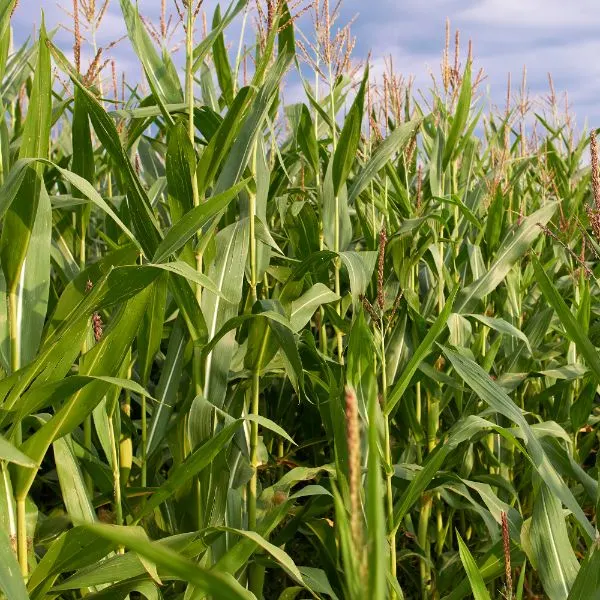
Corn is vulnerable to a variety of pests, including aphids. It might be harmful to your eggplant by attracting pests and limiting its development.
Another plant that competes for resources and attracts pests is corn. More fertilizer is required for corn. As a result, it should not be grown near eggplants.
3. Fennel
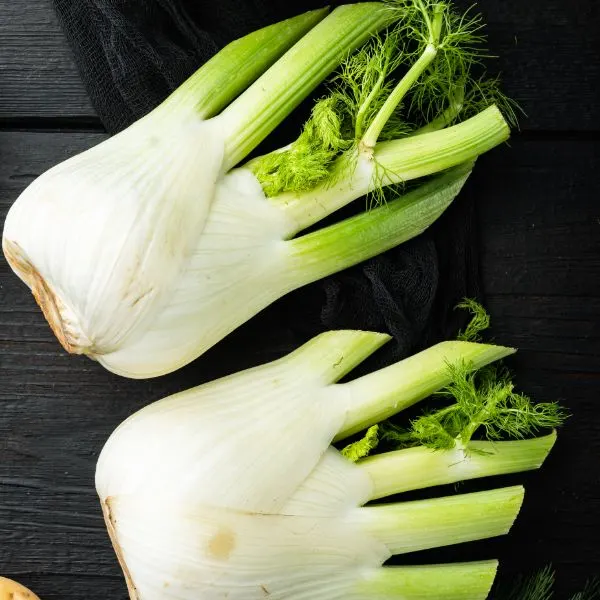
Fennel, along with eggplant, is the greatest offender because it emits a toxin that inhibits development in other plants. This means that the size of your eggplant will suffer.
Fennels deplete soil nutrients, preventing the eggplant from receiving the nutrients it requires to bloom into that beautiful purple vegetable.
Fennel is a Bad Companion Plant that should not be planted near most crops. As Fennel hinders development, therefore, it’s preferable to avoid growing near eggplant.
4. Geraniums
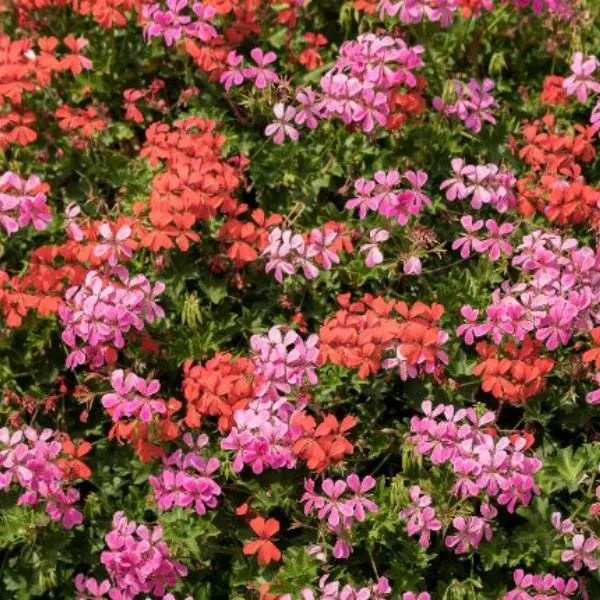
Geranium, if grown with other plants, will act as a pest repellent. Nevertheless, Geraniums are bad eggplant companion flowers and using them will result in disease infections for the eggplant because it’s vulnerable to many diseases.
Although Geraniums are noted for their insect-repellent properties, they are also susceptible to illnesses such as Ralstonia solanacearum, often known as Bacterial wilt.
This disease affects eggplants as well and can be difficult to manage once it begins to spread, making Geraniums an unsuitable companion for eggplants.
5. Zucchini
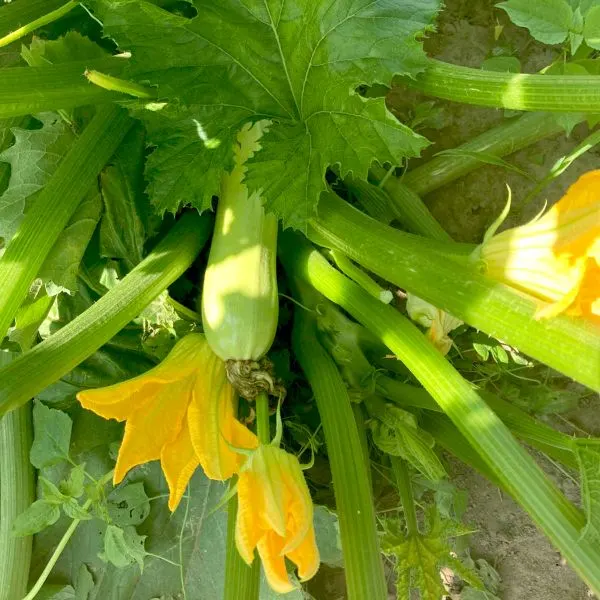
Eggplant and zucchini are also heavy feeders. Zucchini consumes more nutrients than eggplant, causing them to compete for soil resources. So it’s preferable to avoid growing both these plants together.
Also, the zucchini will spread and may get mildew on its leaves; deal with this by staking it well and removing any infected leaves.
Companion plants for eggplant in containers
Container size will have an impact on what you can plant, but some good companion plants for eggplant in containers include basil, marigolds, borage, and nasturtiums.
These plants can help to improve the health and productivity of your eggplant plants by attracting beneficial insects, repelling pests, or improving the soil quality.
Marigolds are a good choice because they produce a chemical that can help to repel nematodes, which are a common pest of eggplants.
Borage and nasturtiums can help to improve the soil quality by adding nutrients and improving drainage.
What to plant after eggplant?
Some good options for planting after eggplants include leafy greens, root vegetables, and legumes. Leafy greens such as lettuce, spinach, and Swiss chard are fast-growing crops that can be planted soon after harvesting eggplants.
Root vegetables such as carrots, beets, and radishes can also be planted in the same space, but they will take longer to mature.
Legumes such as beans and peas can also be planted after eggplants, and they can help to improve the soil by adding nitrogen.
Eggplant frequently asked questions
What is the best fertilizer for eggplant?

Begin by incorporating a lot of compost into the soil, as well as 2 to 3 pounds of a complete fertilizer, such as 15-5-10, per 100 square feet. Ft. Use an organic fertilizer such as blood meal, well-rotted manure, cottonseed meal, or bat guano if you prefer. Burpee’s Big Boy Tomato Food works well with eggplants as well.
How do I make my eggplant bear more fruit?
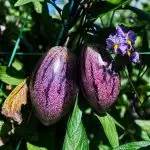
Hand-pollinate the flowers to help increase production if you have a poor fruit set. To help the pollen move within the flowers, use an electric toothbrush to vibrate the flower stems (not the flowers themselves) for a few seconds each. The more frequently the fruits are harvested, the greater the fruit set.
Should I pinch off eggplant leaves?
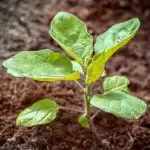
Pinching off these suckers while they’re little will help the plant to spend more of its energy on fruit development, resulting in bigger, more stunning eggplants.
Should I top my eggplants?
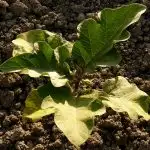
Just like all the other veggies in the yard, ultimately, the cold weather will knock your eggplants about. But before the winter season arrives, you should top (remove the growing point) your eggplants at the same time and in a similar way as your tomato plants.
Can I pick eggplant when they are small?
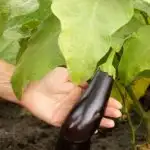
You cannot harvest eggplants too early. Baby eggplants are a treat to eat. However, it would be best if you did not leave them for too long—harvest eggplant when it is one-third to two-thirds full mature size.
What is the secret to growing eggplant?
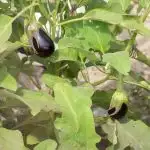
To thrive and produce, eggplant, like other members of the nightshade plant family, requires full light. One of the most important and key things to do in order to grow an eggplant well is to provide it with lots of light. Eggplant is a lovely plant in the Garden, with enormous leaves and bright fruit that hangs from the branches.
How do I get my eggplant to flower?
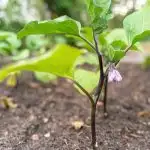
The soil’s nutrients must be adjusted for your eggplants to develop and blossom into blooms. Don’t expect to see eggplant blooming very soon if your soil lacks phosphorus. The same is true if you use a nitrogen-rich fertilizer, which increases the nitrogen percentage in the soil needlessly.
Can I plant eggplant near cucumbers?

Yes, you can plant eggplant near cucumbers. Eggplants and cucumbers are both members of the nightshade family, and they can be planted in close proximity to each other without any problems.
What can I plant next to aubergine?
Can I plant peppers and eggplant together?

es, you can plant peppers and eggplants together in the same garden bed. Just be sure to space them out so they can both get natural sunlight, water, and enough nutrients from the soil.
Can basil and eggplant be planted together?

Yes, basil and eggplant can be planted together in the same garden bed. Both of these plants are warm-season crops that thrive in similar growing conditions. One cool thing about basil is that it is often planted with other plants to help repel pests.
Conclusion
Aubergine, known as eggplant, is a plant species in the family Solanaceae, also known as the Nightshades Family. We have been able to look into Thirty-Five (34) Good companions and also Five (5) Bad Companion Plants.
They are abundant in fiber, antioxidants, vitamins, and minerals, all of which are needed by the body for good health and function. Consumption of eggplant may assist improve heart health, diabetic problems, cancer risk, and cognitive function. Eggplant may aid in the improvement of bone mineral density and the prevention of osteoporosis.
Aubergines need a lot of heat and light to harvest well; thus, they should be cultivated in a greenhouse. They can be cultivated outdoors, but only in moderate climates or during very hot summers. Eggplant grows best in well-drained sandy loam or loam soil with a high organic matter content. Cool temperature conditions are often associated with eggplant growth difficulties.
Check out more types of things

